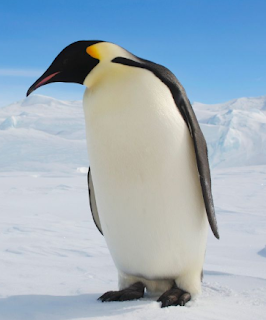Penguins
1. Scientific classificatione
2. Physical characteristics
- Size
The emperor penguin is the largest of all living penguins, standing to 1.1 m (3.7 ft.) tall and can weigh more than 41 kg (90 lbs.).
The smallest of the penguins is the little penguin, standing just 41 to 45 cm (16 to 18 in.) and weighing about 1 kg (2.2 lbs.).
- Body Shape
A Penguin has a large head, short neck, and elongated body.
The tail is short, stiff, and wedge-shaped.
The legs and webbed feet are set far back on the body, which gives penguins their upright posture on land.
- Flippers
Wings are modified into paddle-like flippers. The bones are flattened and broadened, with the joint of the elbow and wrist almost fused. This forms a tapered, flat flipper for swimming.
Each flipper is covered with short, scale-like feathers. The long wing feathers typical of most birds would be too flexible for swimming through water.
Instead of having wings like other birds, penguins have tapered, flattened flippers for swimming.
Penguins propel themselves through the water by flapping their flippers.
- Head
Different species of penguins can be identified by their head and facial markings. Penguins have a variety of bill shapes.
- Generally, the bill tends to be long and thin in species that are primarily fish eaters, and shorter and stouter in those that mainly eat krill.
- The mouth is lined with horny, rear-directed spines to aid in swallowing live prey.
Eyes.
- The color of irises varies among the species.
- Many species have brown, reddish-brown, or golden-brown eyes.
- Rockhopper and macaroni penguins have red eyes.
- Fairy (little blue) penguins have bluish-gray eyes.
- As their name implies, yellow-eyed penguins have yellow eyes.
- Nearly all birds studied have circular pupils.
- Legs and Feet
Penguin legs are short and strong. Feet are webbed, with visible claws. The legs are set far back on the body to aid in streamlining and steering while swimming. This placement also causes penguins to stand vertically and walk upright.
Penguins walk with short steps or hops, sometimes using their bills or tails to assist themselves on steep climbs.
Emperor and king penguins walk slowly and do not hop.
Some species, like the rockhopper penguins, jump from rock to rock.
- Tail
A penguin's tail is short, and wedge-shaped, with 14 to 18 stiff tail feathers. Adélie, gentoo, and chinstrap penguins (collectively known as brush-tailed penguins) have longer tail feathers, which they often use as a prop when on land.
- Feathers
Shiny feathers uniformly overlap to cover a penguin's skin. Penguin feathers are highly specialized. They are short, broad, and closely spaced. This helps keep water away from the skin. Tufts of down on the feather shafts increase the insulative properties of the feathers.
Penguins have more feathers than most other birds, with about 100 feathers per square inch.
- Coloration
All adult penguins are countershaded: dark on the dorsal (back) surface and white on the ventral (underside) surface. The dark dorsal side blends in with the dark ocean depths when viewed from above. The light ventral side blends in with the lighter surface of the sea when viewed from below. The result is that predators or prey do not see a contrast between the countershaded penguin and the environment.
Many species have distinct markings and coloration.
- Sexual dimorphism
Generally, penguins are not sexually dimorphic: males and females look alike. Crested penguins are exceptions: the males are more robust and have larger bills than females.
When seen in pairs during breeding season, royal penguins are one of the easiest penguins species to visually identify males from females. Males have larger bills and white cheeks while females often have gray colored cheeks.
3. Habitat
Penguins generally live on islands and remote continental regions free from land predators, where their inability to fly is not detrimental to their survival.
These highly specialized marine birds are adapted to living at sea — some species spend months at a time at sea. Penguins are usually found near nutrient-rich, cold-water currents that provide an abundant supply of food.
4. Types of Penguins
There are several types of penguins, including
- King penguins, Aptenodytes patagonicus
- Emperor penguins, Aptenodytes forsteri
- Adelied Penguins, Pygoscelis adeliae
- Rockhopper penguins, Eudyptes chrysocome
- White flippered penguins, Eudyptula albosignata
- Africa penguins (Jackass penguins), Spheniscus demersus
- Galapagos penguins, Spheniscus mendiculus
5. Food preferences and resources (Diet)
Penguins eat krill (a shrimp-like crustacean in the family Euphausiidae), squids, and fishes. Various species of penguins have slightly different food preferences, which reduce competition among species.
The smaller penguin species of the Antarctic and the subantarctic primarily feed on krill and squids. Species found farther north tend to eat fishes.
6. Life cycle



Komentar
Posting Komentar